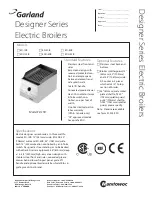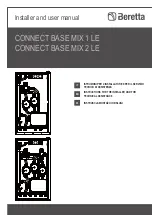
© MHG Heating Ltd
MHG Heating Ltd, Unit 4 Epsom Downs Metro Centre, Waterfield, Tadworth, Surrey, KT20 5LR
P:0845 6448802 F:0845 6448803 E:
W: www.mhgheating.co.uk
010617
64
16.2 Routine Cleaning & Maintenance(E:105 Indication Reset via H630 bit 6 0-1)
As part of the Routine Service Inspection, certain areas of the boiler need to the checked and
cleaned as necessary.
a)
Turn the boiler OFF at the ON/OFF switch and electrically isolate the boiler by removing
the plug or fuse from the boiler supply.
b)
Turn off the gas at the boiler isolation tap, fitted by the installer, adjacent to the
appliance.
c)
Remove both electrical connections from the module fan assemble.
d)
Disconnect the earth lead, HT cap and Lead from the ignition electrodes.
e)
If installed remove the combustion air intake duct from the combustion fan air inlet
elbow.
f)
Remove the ‘Circlip’ securing the gas injector into the fan inlet elbow and extract the
gas valve and injector assembly. (Inspect and clean both the injector and gas valve
assembly.)
g)
Disassemble the burner by removing the six M6 nuts around the burner door, using a
10mm Spanner. Pull the burner forward and remove from the heat exchanger. Gently
put to one side.
h)
Once access has been gained to the combustion chamber and front section of the heat
exchanger, visually inspect the heat exchanger coils.
It is usually only necessary to clean the front section of the heat exchanger. If server
deposits are found, the rear section of the heat exchanger should also be checked and
cleaned, which will necessitate the removal of the heat exchanger from the boiler.
If any coils appear to be significantly dis-coloured, then a blockage of eitherscale,
magnetite, or general system debris has occurred which will have allowed excessive
overheating to have occurred within the coil.
If dis-colouration has occurred, then specialist de-scaling of the heat exchanger will be
required, however, stress cracking may have occurred, and the heat exchanger may
become porous following the de-scale works.
i)
If the heat exchanger has not suffered from dis-colouration, as ‘Item h’ above, then a
Standard Service can be undertaken. Using a natural bristled brush ONLY, remove the
worst of the mineral/debris buildup.
With the use of the dissolved
ProConCombustion Chamber Cleaning Granules
, spray the
solution onto the heat exchanger surface and leave for approximately 5 minutes. This
will help to remove any stubborn mineral deposits. Finally brush the heat exchanger
whilst rinsing thoroughly with copious amounts of fresh water.
ProConCombustion
Chamber Cleaning Granules
are available from MHG Heating Ltd Spares Department. A
STEEL OR PVC BRUSH MUST NOT BE USED TO CLEAN THE HEAT EXCHANGER.
j)
Following the cleaning of the Heat Exchangers, the condensate syphon must be flushed
to ensure that all mineral deposits/debris that has been washed from the heat
exchanger surface is correctly removed. Open the syphon cleaning point cap at the base
of the boiler, with a suitable receptacle directly below to collect the syphon contents.
Safely dispose of the contents of the syphon. Replace the receptacle below the cleaning
point and poor 2 litres of clean tap water into each of the heat exchangers, which will
drain through the cleaning point. Refit the cleaning point cap and poor half a litre of
clean tap water into one of the heat exchangers to ensure the syphon is re-flooded.
Check the cleaning point cap for leaks.
k)
Visually check the burner surface for signs of damage and debris build-up. Remove any
debris buildup with compressed air.
l)
Remove the burner lance from the burner door to access the internal Non Return Valve.
Clean the spindle to ensure that the flap moves freely. Whilst the burner lance is
removed clean the internal surface with a lint free cloth. If excessive debris build-up is
identified, the burner lance should be washed and thoroughly dried. A BRUSH, OF ANY













































